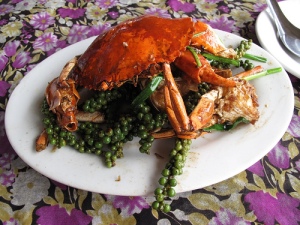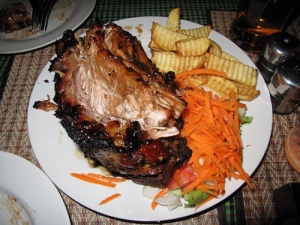This tiny town sure gave us a lot to talk about.
We spent a fair proportion of our time in Kampot indulging in two of the less frequented meats of our diet – pork and crab. It’s not that we don’t enjoy these meats – quite to the contrary, in fact – but too much of the former has, at times, been known to upset the Dodd guts and as for the latter, expense, lack of education and can’t-be-arsedness (edible meat of most crab is estimated at only 15% of the total weight) has limited our consumption. In these parts, there ain’t no picked-for-your-convenience crab meat or purpose-designed crab wrangling tools – it’s you, the whole beast and a spoon: a little intimidating.
But with a little bit of internet-enabled help, we’ve broken through the crab barrier. As it was, the crab came out already portioned but our new skills still enabled us to extract every skerrick of edible goodness. Sweet flesh with fresh green peppercorns, another local specialty, it was perfectly accompanied by a grilled and seasoned fishy friend and a few icy Angkors. Yum.
As for the pork, the baby back ribs at The Rusty Keyhole are justifiably famous in these parts. The affable Brit that runs the place must single-handedly keep the local piggery afloat. Double yum.
Meat aside, most people come to Kampot to visit Bokor, a former French hill station and “national park”. But it’s a strange sort of national park where the government accepts the paltry sum of US$100m in exchange for a 99-year lease to Cambodia’s largest business conglomerate with plans afoot for a golf resort and casino. But that just seems to be how things work here – check out this article from the Guardian which details how the Cambodian government has happily sold off other large chunks of land in a similar fashion.
And now for the “physical challenge” part.* Control of the site by Sokhimex explains why the cost of visiting Bokor has skyrocketed, as local tourism operators now have to pay considerable bribes to be allowed to lead visitors onto the site. And it also explains why we had to hike halfway up the mountain, which was previously accessible by road, led by a young guy toting a rusty AK47.
Its worth noting at this point just how many tourists in this part of the world are French. They seemingly still hold some sort of colonial fondness for Indochina and they’re everywhere. Notably, their government seems to pour a lot of money into funding archaeological digs and French cultural centres, while the Australians and Kiwis waste their time with more frivolous matters such as targeting child sex tourism and public health campaigns, but I digress…
Most of our hiking group was French and, as became obvious, fairly urbane. When we enquired about the tour, we were specifically told it would involve 2.5 hours of hiking each way and thus, we should be suitably attired. If you’re French, “suitably attired” means dainty sandals, a long flowing skirt and a silk scarf. “But zere will be mud? Quelle horreur!” Thankfully, the girls managed to rustle up some other clothes and footwear, but the guys persisted with Birkenstock slip-ons/thongs which were quickly discarded in favour of bare feet. Hmm, does anyone know the French word for “hookworm”? At least the trip back down the muddy embankment in bare feet may have resembled an activity more familiar to them: downhill skiing. All this, of course, only enhanced their stereotypically grumpy demeanour as they sulkily puffed away on their fags at each rest stop.
But enough French-bashing. At just over 1000m above sea level, Bokor is refreshingly cold and usually shrouded in mist, which gives a suitably eerie feeling to the abandoned buildings – a church, post office and hotel, which would have been particularly grand in its day. No pics, as it was raining and we’re still treating the camera with kid gloves but there’s heaps online.
The final word must go to our guide Cheung Try who, at 51 and with 5 children, looks barely a day over 35. We had heard him stick the boot into the government in an earlier monologue about Bokor’s history and wanted to ask him some questions about the sale of the national park, which then progressed into a telling of his own history. Cheung Try was 18 when his family were murdered by the Khmer Rouge; their crime was that his father had once been an officer in the Republican army. He managed to escape his captors and fled to the jungle where he hid for many months. Eventually he made his way to the border and joined the Vietnamese-backed resistance. He fought to take that very hill station from the KR who used it as a command post and his leg is scarred from the injuries he sustained. After the Vietnamese liberated Cambodia, he stayed in the army and continued to fight against the KR in the north until 1991. He then worked for the UN for seven years, clearing mines in the Kampot region. He learned English while working alongside Australian soldiers, who sent him money long after they left so he could educate his kids. Despite nearly 20 years of active service, he receives no pension and now contracts his services as a guide to local tourism operators.
As Cheung Try sat on a pile of gravel, talking and noshing on his lunch, we were both reminded of our days in East Timor where everyone we met had a story of loss to tell. There’s not a lot you can do or say in response, except be humbled.
*Hilarious reference to late 80s/early 90s children’s game show Double Dare – “Dare! Double Dare! Physical challenge!!” – “Yum! Double yum! Physical challenge!!” Get it? Never mind…





